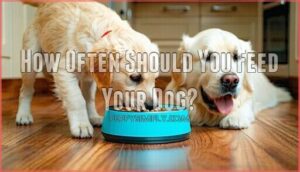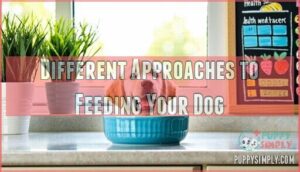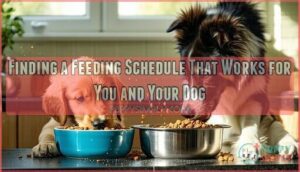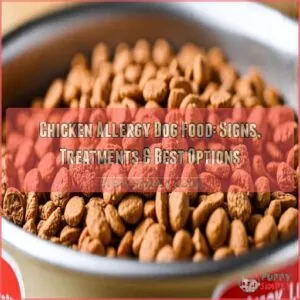This site is supported by our readers. We may earn a commission, at no cost to you, if you purchase through links.
 It’s not cruel to feed your dog once a day, but it’s not ideal either.
It’s not cruel to feed your dog once a day, but it’s not ideal either.
While healthy adult dogs can handle single daily meals without harm, this feeding pattern can leave them hungry for longer stretches and may increase bloat risk in larger breeds.
Most vets recommend splitting your pup’s daily food into two meals instead – think of it like choosing between one massive dinner or balanced breakfast and dinner.
Your dog’s size, age, and health all factor into what works best, and single feeding might suit some dogs perfectly, while others thrive on multiple smaller meals throughout their day.
Table Of Contents
- Key Takeaways
- The Pros and Cons of Once-a-Day Dog Feeding
- Best Time to Feed Your Dog Once a Day
- Can Dogs Be Fed Three Times a Day?
- Choosing The Ideal Feeding Time for Your Dog
- How Often Should You Feed Your Dog?
- Determining The Right Amount to Feed Your Dog
- Selecting The Right Food for Your Dog
- Why a Proper Feeding Schedule is Important for Dogs
- Different Approaches to Feeding Your Dog
- The Impact of Feeding Table Scraps to Dogs
- Finding a Feeding Schedule That Works for You and Your Dog
- Frequently Asked Questions (FAQs)
- Is it OK to feed dogs 1x a day?
- Can I train my dog to eat once a day?
- When should I switch my dog to one meal a day?
- Is it okay to not feed your dog for a day?
- Are there any health risks associated with feeding my dog once a day?
- Is once-a-day feeding suitable for puppies?
- What is the best way to transition my dog to once-a-day feeding?
- Is once daily feeding considered animal abuse?
- What do veterinarians say about feeding frequency?
- How does feeding frequency affect dog behavior?
- Conclusion
Key Takeaways
- You won’t harm your dog by feeding once daily, but it’s not ideal – while healthy adult dogs can handle single meals, they’ll be hungrier longer and face increased bloat risk, especially larger breeds.
- You should split your dog’s daily food into two meals instead of one – this approach mimics natural eating patterns, improves digestion, and reduces the risk of dangerous stomach bloating that can be life-threatening.
- You’ll need to consider your dog’s specific needs when choosing feeding frequency – puppies, seniors, small breeds, and dogs with health conditions require more frequent meals than once daily to maintain stable blood sugar and proper nutrition.
- You can successfully transition to any feeding schedule with gradual changes – shift meal times by 15-30 minutes every few days, monitor your dog’s behavior and energy levels, and consult your vet if you notice digestive issues or concerning changes.
The Pros and Cons of Once-a-Day Dog Feeding
You’ve probably wondered if feeding your dog once a day makes you a terrible pet parent, but the reality isn’t so black and white.
While once-daily feeding can offer genuine health benefits for some dogs, it’s not the right choice for every pup and comes with its own set of risks you’ll need to ponder.
Benefits of Once-Daily Meals
Several surprising benefits emerge when you switch to once a day feeding for your dog.
Research shows this approach can substantially boost your pet’s health and wellbeing.
Here are 5 key advantages of single daily meals:
- Improved Digestion – Allows your dog’s digestive system complete rest between meals
- Weight Management – Helps prevent overeating and maintains healthy body weight
- Mimics Nature – Reflects how wild canines naturally eat in larger, less frequent portions
- Gut Health Benefits – Promotes better nutrient absorption and reduces digestive stress
- Dental Benefits – Concentrated chewing time helps clean teeth naturally
This feeding frequency supports your dog’s natural rhythms while optimizing their overall health.
This method also mirrors the ancestral eating patterns of their wolf ancestors.
Drawbacks of Once-A-Day Meals
While once a day feeding might sound convenient, it comes with real risks you shouldn’t ignore. Bloat risk increases dramatically when your dog wolfs down large portions, especially dangerous for deep-chested breeds. This digestive emergency can be life-threatening.
Don’t let convenience put your pup at risk—large portions can turn mealtime into a medical emergency.
Nutrient deficiencies become more likely when your pup’s entire nutritional needs get crammed into one meal. Their body can’t absorb everything efficiently at once. You’ll also notice lethargy signs as blood sugar levels crash between those long fasting periods.
Food aggression often develops when dogs feel meal scarcity. They’ll guard their bowl aggressively or inhale food too quickly. Digestive upset like vomiting and diarrhea frequently occurs from overloading their stomach. Some dogs may also exhibit picky eating habits if only offered one large meal.
While once a day feeding isn’t necessarily animal cruelty, these dog feeding concerns show why most vets recommend splitting meals. Your dog’s dog health depends on consistent nutrition, not feast-or-famine cycles.
Best Time to Feed Your Dog Once a Day
Timing your dog’s once daily feeding makes all the difference for their health and happiness.
Most dogs thrive when fed at consistent times, whether morning or evening works best for your schedule.
Here’s what to examine for ideal timing:
- Morning feeding gives energy for the day’s activities
- Evening meals help dogs settle down for nighttime rest
- Midday feeding works well for consistent 24-hour spacing
- Activity levels should align with meal timing for better digestion efficiency
- Medication timing may require specific feeding schedules
Breed considerations matter too – larger dogs need more time between meals and exercise.
Can Dogs Be Fed Three Times a Day?
While once-daily feeding works for some dogs, you might wonder if three meals per day is better. The answer is absolutely yes – and for many dogs, it’s actually ideal.
Three meals work perfectly for specific situations. Puppy three meals help growing dogs get steady nutrition without overwhelming their small stomachs. Senior dog feeding often benefits from smaller, more frequent portions since older dogs can struggle with large meals.
If your furry friend has medical condition needs like diabetes or digestive issues, spreading food throughout the day helps manage symptoms. This feeding frequency isn’t cruelty – it’s smart planning. Small frequent meals aid digestion better than one huge serving.
Your active dog schedule might demand this approach too, especially if your pup burns calories throughout the day. The beauty of three meals lies in flexibility. You’re not forcing your dog to wait 24 hours between feedings, and you’re reducing bloat risks.
Many owners find this dog feeding schedule works better for their lifestyle while keeping their pets satisfied and healthy.
Choosing The Ideal Feeding Time for Your Dog
You’ve decided on your dog’s feeding frequency, but timing matters just as much as how often you fill that bowl.
Whether you’re feeding once, twice, or three times daily, picking the right moments can make the difference between a happy, healthy pup and one dealing with digestive upset or behavioral issues.
Before or After Walks
Walking your dog right after meals can spell trouble for their digestive system.
You’ll want to wait at least 30-60 minutes after feeding before heading out for exercise.
This timing helps prevent bloat risk, especially in larger breeds prone to this dangerous condition.
Energy levels actually improve when you respect proper digestion timing – your pup won’t feel sluggish from processing food during walks.
If you’re following a once daily feeding schedule, plan walks before mealtime when possible.
This approach supports better digestion and reduces behavioral concerns like food guarding.
Some owners worry this timing seems like cruelty, but it’s actually healthier.
Exercise timing matters more than you think – your dog’s behavior and comfort depend on getting this balance right for their feeding schedule.
Respecting proper digestion and digestive system needs is crucial for your dog’s well-being.
How to Change Your Dog’s Feeding Schedule
Most pet parents find that switching their dog’s feeding schedule feels like exploring unfamiliar territory. However, with the right approach, you can make this change smooth and stress-free for both you and your furry friend.
Gradual transition is your best friend here. Never shock your dog’s system with sudden changes – their digestive system needs time to adapt. Start by shifting meal times by 15-30 minutes every few days until you reach your desired schedule.
Here’s what successful feeding schedule changes look like:
- Your dog enthusiastically anticipates meals without showing signs of anxiety or behavioral issues
- Digestive monitoring reveals normal bowel movements and no vomiting episodes
- Portion adjustment flows naturally as your dog adapts to new timing
- Behavioral changes remain minimal with consistent energy levels throughout the day
Veterinary consultation becomes vital if you notice persistent digestive problems or concerning dog behavior changes. Remember, feeding frequency adjustments affect more than just meal times – they impact your dog’s entire daily routine and overall well-being.
How Often Should You Feed Your Dog?
You’ve probably wondered if your dog’s current feeding schedule is actually what’s best for them.
The answer isn’t as straightforward as you might think – it depends on your dog’s age, size, health, and individual needs, with options ranging from once daily to several smaller meals throughout the day, considering their size and other factors.
Feeding for Adult Dogs
Most adult dogs thrive on a twice-daily feeding schedule that keeps their energy steady and stomachs happy. Your dog’s meal frequency should typically include breakfast and dinner spaced 8-12 hours apart – think of it as their version of your morning coffee and evening dinner routine.
However, dog feeding frequency isn’t one-size-fits-all. Some healthy adult dogs can handle once a day feeding, especially larger breeds eating raw diets. But this approach requires careful portion control and attention to your dog’s dietary needs.
Breed specifics matter too – smaller dogs often need more frequent meals to maintain stable blood sugar. The food type you choose also influences timing. Consider nutritional needs with kibble when planning meal schedules.
Kibble expands in the stomach, so large portions can cause discomfort. Watch your dog’s behavior and energy levels, and consult your vet before making significant changes to guarantee the best dog health.
Feeding Puppies
Growing puppies need more frequent meals than adult dogs to fuel their rapid development and prevent malnourishing their developing bodies.
Unlike adult dogs who can handle once-daily feeding, puppies require consistent fuel throughout the day to avoid nutrient deficiencies that could stunt their growth.
Your puppy’s feeding frequency should match their age and energy needs. Young pups burn calories quickly and can’t store enough energy from a single large meal. Think of it like trying to fuel a race car with just one gas stop – it won’t make it to the finish line.
Here’s what puppy meal frequency looks like:
- Birth to 3 months: Feed 4 times daily for ideal growth stage feeding
- 3 to 6 months: Reduce to 3 meals as they mature
- Small breed needs: Maintain frequent feeding longer due to faster metabolisms
- Raw puppy diets: May switch to fewer meals sooner than kibble-fed pups
Consistent weaning diet schedules help establish healthy eating patterns for life. You can find products related to puppy feeding supplies online.
Feeding a Sick Dog
Sick dogs require different feeding approaches than healthy adults.
When illness strikes, your dog’s digestion and gastrointestinal health become top priorities.
Here’s how to adjust their routine:
- Wait 12-24 hours after vomiting before offering food, allowing their stomach to settle completely.
- Start with small, bland meals like boiled chicken and rice to ease digestion back into gear.
- Monitor appetite stimulation closely – some dogs need encouragement while others naturally eat less during recovery.
- Coordinate medication timing with meals as prescribed, ensuring proper absorption and reducing stomach upset.
Always seek veterinary guidance for medical conditions requiring dietary adjustments.
You may also need to find appropriate sick dog food for your pet.
Determining The Right Amount to Feed Your Dog
Figuring out the right portion size doesn’t have to be rocket science. Start with your dog food’s feeding guidelines, but remember these are just starting points. Your dog’s age, activity level, and metabolism all play vital roles in determining their nutrient needs.
| Dog Weight | Daily Calories | Portion Control Tip |
|---|---|---|
| 10-20 lbs | 200-400 calories | Use measuring cups, not guesswork |
| 30-50 lbs | 500-900 calories | Split into smaller meals if needed |
| 60+ lbs | 1000+ calories | Monitor weight weekly |
Food labels provide calorie information for accurate calorie calculation. Weight management becomes easier when you’re consistent with portion sizes. Active dogs need more fuel, while couch potatoes need less. Don’t forget to account for treats in your dog’s daily intake – they count toward total calories too.
To guarantee your dog maintains a healthy weight, consider adjusting portion sizes based on their individual needs.
Selecting The Right Food for Your Dog
Choosing the right food for your dog isn’t rocket science, but it does require some homework. Start by considering your dog’s life stage – puppies need different nutrition than senior dogs. Breed specifics matter too, since a Chihuahua’s needs differ vastly from a Great Dane’s.
Check ingredient quality by reading labels carefully. The first few ingredients should be recognizable proteins, not mysterious byproducts. Pay attention to your dog’s nutritional needs based on activity level and health status.
Food allergies can throw a wrench in your plans, so watch for signs like itching or digestive upset. A quality canine diet supports everything from shiny coats to strong bones. Don’t get swayed by fancy marketing – focus on proven dog nutrition standards.
Your vet can help determine the ideal dog diet that’ll keep your furry friend thriving, regardless of how often you’re planning to fill that food bowl, ensuring a healthy and happy life for your pet.
Why a Proper Feeding Schedule is Important for Dogs
Beyond convenience, a proper dog feeding schedule acts as your pet’s internal compass, guiding their metabolic health and overall well-being.
Consistent feeding frequency supports digestive regularity while maintaining steady energy levels throughout the day.
Poor scheduling can trigger behavioral impacts like food aggression or anxiety.
Your dog’s body clock depends on routine for vital nutrient absorption, making timing just as important as what you’re serving.
Think of it as setting your pup’s biological rhythm—when you get it right, everything else falls into place naturally.
Ensuring proper nutrition is especially important for puppies, where a strict routine and frequent feeding guidelines are essential for healthy development.
Different Approaches to Feeding Your Dog
You’ve got three main feeding strategies to choose from, and each one puts a different family member in charge of mealtime.
Whether you let your dog decide when to eat, control the portions yourself, or stick to a strict clock schedule, the approach you pick can make a real difference in your pup’s health and your daily routine, with a focus on health.
Dog Controls Feeding
Letting your dog control their own feeding might seem like giving them freedom, but it creates serious self-feeding risks.
Free-feeding dangers include overeating, obesity, and digestive problems when dogs graze throughout the day.
Without portion control, you can’t monitor their appetite or notice early signs of illness.
Some dogs develop anxiety around food bowls, leading to behavioral issues like guarding or aggressive eating habits.
Food puzzles offer a compromise—they slow down eating while engaging your dog’s natural hunting instincts.
However, most dogs thrive with structured meal times rather than constant access to food.
When dogs control feeding frequency, it disrupts their natural digestion patterns and makes it harder to establish healthy routines.
Your guidance guarantees they get proper nutrition without the chaos of uncontrolled munching.
You Control Portions
Your dog’s portion size becomes your responsibility when you take control of their meals.
This approach lets you tailor balanced meals to your pup’s specific needs, preventing overfeeding risks that come with free-feeding.
Measuring food and calorie counting help guarantee they’re getting just enough fuel without excess weight gain.
Whether you’re feeding once a day or multiple times, controlling portions means you can adjust for their activity level and age.
However, this method requires attention to detail.
Too little food can leave your dog genuinely hungry, while miscalculating portions might lead to nutritional gaps.
The key is finding that sweet spot where your furry friend feels satisfied without facing starvation or overindulgence.
The Clock Controls Feeding
From controlling portions to letting time call the shots, scheduled meals create predictable digestive rhythms for your furry friend.
Setting consistent timing helps establish behavioral expectations around feeding frequency, whether you’re doing once a day or multiple meals.
- Regular hunger patterns develop when meals arrive on schedule
- Digestive systems function better with routine feeding schedules
- Training opportunities emerge through structured meal frequency timing
The Impact of Feeding Table Scraps to Dogs
You’ve mastered your dog’s feeding schedule, but what about those puppy-dog eyes begging for your leftover pizza? Here’s the scoop on table scraps and your pup’s wellbeing.
Feeding table scraps creates more problems than solutions for responsible pet ownership. Research shows 60% of human food contains ingredients harmful to dogs, raising serious toxicity concerns. That innocent bite of onion or chocolate could spell disaster.
Beyond safety, table scraps disrupt nutritional value in your dog’s balanced diet, leading to digestive issues and weight management problems. The behavioral impacts are equally troubling, with regular table feeding destroying impulse control and creating persistent begging.
Your dog might develop food aggression or anxiety around mealtimes. Smart pet care tips prioritize structured feeding over kitchen handouts, supporting long-term animal welfare through consistent nutrition.
Finding a Feeding Schedule That Works for You and Your Dog
Three key factors shape your dog’s ideal feeding schedule, but finding the right balance doesn’t have to feel overwhelming.
Every dog’s unique, so what works for your neighbor’s pup mightn’t suit yours.
- Individual Dog Needs: Consider your dog’s age, size, and activity level when planning feeding frequency
- Food Type Matters: Raw diets digest differently than kibble, affecting how often you’ll need to feed
- Veterinary Consultation: Get professional guidance before making gradual schedule changes to monitor your dog’s health and support their feeding habits for long-term wellness.
For large breeds, it’s also vital to understand their growth sensitivity period to prevent potential health issues.
Frequently Asked Questions (FAQs)
Is it OK to feed dogs 1x a day?
Like wolves hunting in the wild, your dog can thrive on once-daily feeding if they’re healthy adults.
However, puppies, seniors, and small breeds need more frequent meals for ideal health and energy, which can be a critical aspect of their care.
Can I train my dog to eat once a day?
Yes, you can gradually train your dog to eat once daily.
Start by slowly extending time between meals over several weeks.
However, consult your vet first, especially for puppies, seniors, or dogs with health conditions.
When should I switch my dog to one meal a day?
Switching your dog’s feeding schedule isn’t rocket science!
You can switch adult dogs over 20 pounds to once-daily meals after they’re fully grown.
But consult your vet first, especially for small breeds or dogs with health issues.
Is it okay to not feed your dog for a day?
No, you shouldn’t skip feeding your dog for an entire day.
Dogs need consistent nutrition for their health and well-being.
Missing meals can cause low blood sugar, stress, and digestive issues.
Are there any health risks associated with feeding my dog once a day?
Feeding once daily can pose risks like bloating, especially in large breeds, blood sugar drops, and digestive upset.
Small dogs and puppies shouldn’t eat once daily—they need frequent meals for proper health.
Is once-a-day feeding suitable for puppies?
No, once-a-day feeding isn’t suitable for puppies. They need frequent meals—at least four times daily until three months, then three until six months. Their growing bodies require consistent nutrition.
What is the best way to transition my dog to once-a-day feeding?
Gradually reduce meals over 7-10 days.
Start by making breakfast smaller, then eliminate it entirely.
Monitor your dog’s energy and appetite closely. If they seem uncomfortable or lethargic, consult your vet immediately.
Is once daily feeding considered animal abuse?
Like a balanced scale, feeding your dog once daily isn’t abuse if done properly.
You’ll need adequate nutrition, proper portions, and veterinary guidance.
It’s not cruel when health needs are met, and doing it properly is key to ensuring the dog’s well-being.
What do veterinarians say about feeding frequency?
Veterinarians emphasize that nutrient adequacy matters more than feeding frequency.
They recommend twice-daily feeding as ideal for most adult dogs, but say once-daily can work if you’re monitoring your dog’s health closely.
How does feeding frequency affect dog behavior?
Feeding frequency impacts your dog’s behavior substantially.
Once-daily feeding can trigger anxiety, food aggression, or overeating.
Dogs may become more food-motivated, beg excessively, or gulp meals too quickly, leading to digestive issues.
Conclusion
Like choosing the perfect outfit for your dog’s needs, finding the right feeding schedule requires considering your pup’s unique circumstances.
While it’s not cruel to feed your dog once a day, splitting meals into two portions typically works better for most dogs.
Consider your dog’s size, age, and health when deciding. Remember, consistency matters more than perfection – whether you choose one meal or multiple feedings, stick to a regular schedule that keeps your furry friend happy and healthy.
- https://pubmed.ncbi.nlm.nih.gov/35484470/
- https://pmc.ncbi.nlm.nih.gov/articles/PMC9213604/
- https://thegratefulpet.sg/benefits-of-a-once-a-day-feeding-schedule-for-dogs/?srsltid=AfmBOoqtsyHLLkAVR2bY5bW68zmMo5MFPPwFTH3k-QMXvYZVA3bH6dIk
- https://dogagingproject.org/once-daily-feeding-is-associated-with-better-health-in-companion-dogs
- https://dogsnet.com/pros-and-cons-of-feeding-your-dog-once-a-day/














